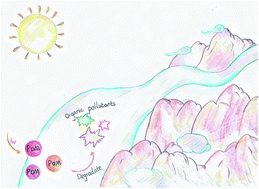Application of polyoxometalates in photocatalytic degradation of organic pollutants
Abstract
Organic pollutants are highly toxic, accumulative, and difficult to degrade or eliminate. As a low-cost, high-efficiency and energy-saving environmental purification technology, photocatalytic technology has shown great advantages in solving increasingly serious environmental pollution problems. The development of efficient and durable photocatalysts for the degradation of organic pollutants is the key to the extensive application of photocatalysis technology. Polyoxometalates (POMs) are a kind of discrete metal-oxide clusters with unique photo/electric properties which have shown promising applications in photocatalytic degradation. This review summarizes the recent advances in the design and synthesis of POM-based photocatalysts, as well as their application in the degradation of organic dyes, pesticides and other pollutants. In-depth perspective views are also proposed in this review.

- This article is part of the themed collection: Recent Review Articles


 Please wait while we load your content...
Please wait while we load your content...